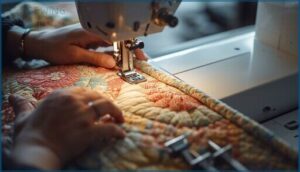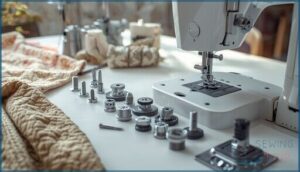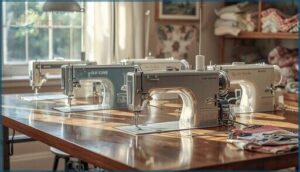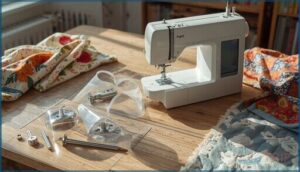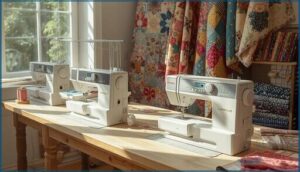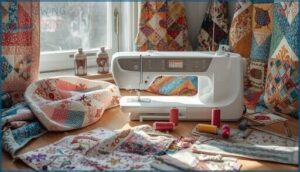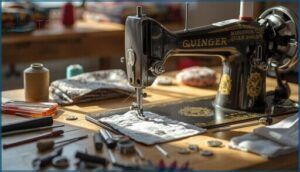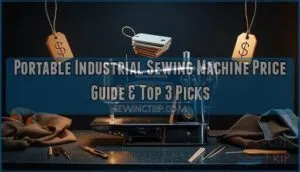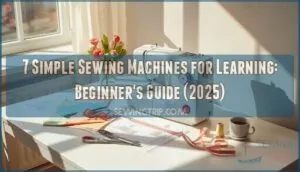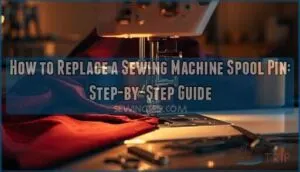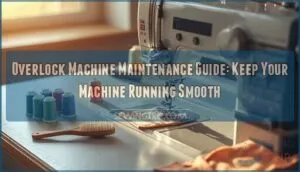This site is supported by our readers. We may earn a commission, at no cost to you, if you purchase through links.

If you’ve ever tried to quilt on a machine with bulky presser feet, you know the struggle—layers bunching, stitches skipping, and that nagging feeling you’re fighting your own tools. Low shank quilting machines flip that frustration on its head. With a compact build and clever accessory options, these models handle intricate piecing and ruler work like a seasoned pro.
Whether you’re hunting for a machine that fits your favorite patchwork foot or want to discover new quilting techniques, understanding low shank models puts you in the driver’s seat. Here’s what sets these machines apart and how to make them work for your next project.
Table Of Contents
- Key Takeaways
- What is a Low Shank Quilting Machine?
- Low Shank Vs. High Shank Machines
- Popular Low Shank Quilting Machine Brands
- Top Low Shank Quilting Machine Models
- Presser Feet and Accessories for Low Shank Machines
- Ruler Work and Quilting Attachments
- Quilting Features in Low Shank Machines
- Choosing The Right Low Shank Machine for Quilting
- Quilting Projects Suitable for Low Shank Machines
- Tips for Maintenance and Longevity
- Frequently Asked Questions (FAQs)
- Conclusion
Key Takeaways
- Low shank quilting machines offer broad accessory compatibility, making it easy to swap presser feet and tackle a variety of quilting techniques.
- These models are ideal for home use, excelling at piecing, ruler work, and free motion quilting thanks to their compact design and precise control.
- Popular brands like Brother, Janome, Singer, and Kenmore provide reliable low shank options with features like automatic needle threading and built-in stitch patterns.
- Regular cleaning, careful maintenance, and using the right feet and rulers help low shank machines deliver smooth, accurate stitches and long-lasting performance.
What is a Low Shank Quilting Machine?
If you’re new to quilting machines, the term “low shank” might sound a bit mysterious. Understanding what it means can make choosing the right machine much easier.
Let’s break down what defines a low shank quilting machine and how you can spot one.
Definition of Low Shank Machines
Think of your sewing machine’s shank as its handshake with every presser foot and accessory. A low shank quilting machine features a Shank Height of just 0.5 inches, offering minimal Foot Clearance. This Singer Standard design is the backbone of Domestic Prevalence, making accessory compatibility straightforward. You’ll find these machines excel in adaptability, especially for household quilting. Many beginners find them ideal due to their ease of use.
Here’s what sets low shank machines apart:
- Compact Shank Height
- Limited Foot Clearance
- Broad Accessory Compatibility
- Singer Standard roots
How to Identify a Low Shank Model
Spotting a low shank model is easier than you’d expect. Start with a quick visual inspection—low shank machines sit closer to the needle plate and use Snap-On Feet. For confirmation, check your manual or measure the Shank Height; most show about half an inch.
To accurately identify your machine, measure the shank. If your accessories or rulers fit snugly, that’s another clue. Ruler Compatibility and manual consultation round out your identification process.
Measuring Shank Height
Once you’ve checked your manual, grab a small ruler for Accuracy Factors. With the presser foot down, measure from the screw hole’s center to the needle bed—low shank machines read 0.5 inches or less. Metric Conversion matters if your ruler shows centimeters.
For best Tool Selection and Troubleshooting Errors, always remove adapters first. Brand Variations can shift measurements, so double-check before buying accessories.
- Lower presser foot
- Measure screw hole to bed
- Remove adapters
Low Shank Vs. High Shank Machines
Choosing between low shank and high shank machines can make a real difference in your quilting experience. Each type brings its own design quirks and compatibility needs.
Here’s what you should know before picking the right fit for your projects.
Key Differences in Design
Ever wonder why some machines glide through thick quilts while others struggle? It all boils down to design differences like Shank Height and Foot Attachment. Low shank models keep things compact, perfect for home use, while high shank machines offer extra Ruler Clearance for bulky projects.
Here’s a quick side-by-side:
| Feature | Low Shank |
|---|---|
| Shank Height | 0.5″ or less |
| Ruler Clearance | 1/8″ rulers needed |
| Foot Attachment | Snap-on/screw-on |
| Fabric Handling | Light/medium layers |
Impact on Quilting Techniques
With low shank machines, quilting techniques shift to fit their unique limitations and strengths. Foot clearance is tighter, so you’ll need slimmer presser feet for smooth fabric layering. Stitching speeds may be slower, but precise control improves user experience. Machine adaptations—like specialized walking feet—help you manage multiple layers. Here’s a quick look:
| Technique | Low Shank | High Shank |
|---|---|---|
| Layering Ease | Moderate | High |
| Speed Control | Precise | Faster |
| Foot Clearance | Slim | Spacious |
Shank Types and Machine Compatibility
When you’re exploring shank types, compatibility can feel like weaving through a patchwork of options. High shank machines demand dedicated feet, while low shank models thrive on interchangeability—especially with snap-on systems. Model variations and proprietary systems (think Bernina) may require adapters, but these come with limitations. Identifying feet for your machine is key to avoiding mishaps.
Here’s a quick comparison:
| Feature | Low Shank |
|---|---|
| Adapter Limitations | Few |
| Shank Interchangeability | High |
Popular Low Shank Quilting Machine Brands
If you’re wondering which brands offer reliable low shank quilting machines, you’re in the right place. There are a few names that stand out for their features and compatibility.
Let’s take a closer look at the top options you’ll find on the market.
Brother Low Shank Models
Did you know over 60% of Brother’s home quilting machines use a low shank design? That means you’ll find broad foot compatibility, smart technical features like automatic presser foot lift, and a strong market presence. Ruler attachments fit easily on models like the SQ9285 and BQ2500, making them favorites for quilters who want versatility without extra fuss.
- Wide model prevalence
- Sophisticated technical features
- Reliable ruler attachments
Janome Low Shank Models
Looking for a quilting machine that blends Model Prevalence with real-world durability? Janome’s low shank models stand out, offering up to 300 built-in stitch patterns and universal Foot Compatibility.
You’ll find sophisticated Quilting Features even in portable options. With a Price Range from $179 to $1,299, Janome machines deliver lasting value for piecing, free-motion, and binding projects.
Singer and Kenmore Low Shank Machines
Ever wondered why Singer and Kenmore machines feel so adaptable for quilting? Their 7mm shank height makes Model identification simple and ensures Shank compatibility with a huge range of Quilting accessories.
From walking feet to rufflers, you get reliable Stitch functions, easy snap-on changes, and practical Maintenance tips—perfect for piecing, binding, or tackling thick layers without fuss.
Bernina Low Shank Adapters
Want to access hundreds of presser foot options on your Bernina? Low shank adapters come in two main styles—old and new—each with a quick installation guide.
They boost foot compatibility, letting you use universal feet from brands like Brother and Janome.
Pricing trends hover around $16, and user satisfaction runs high, thanks to versatility and cost-saving accessory choices.
Top Low Shank Quilting Machine Models
If you’re wondering which low shank quilting machines stand out, you’re in the right place. There are plenty of models to choose from, each with its own strengths.
Let’s take a closer look at some of the top options available today.
Bestselling Domestic Models
Among bestselling domestic low shank quilting machines, models like the Singer Quantum Stylist 9960 and Janome 2212 stand out for their market share and model popularity.
Consumer reviews often praise their practical features, such as automatic needle threading and ample built-in stitches.
With price points ranging from $190 to $500, these machines offer strong feature comparison for beginners and intermediate quilters, making them favorites in today’s quilting circles.
Computerized Vs. Mechanical Options
After exploring bestselling models, you’ll notice how computerized and mechanical low shank machines each bring their own flavor to quilting. Computerized options stand out for Stitch Customization and Automation Benefits, making pattern work easier and faster. Mechanical machines, on the other hand, win points for lower Maintenance Costs and better Energy Efficiency.
Market Trends show computerized units leading in popularity, but many quilters still appreciate the reliability of a manual approach.
Price Range and Availability
If you’re weighing Budget Considerations, low shank quilting machines usually run $300–$900, with entry-level models at the lower end. Online Marketplaces like Amazon and eBay offer steady stock, but Model Fluctuation is common, especially during seasonal sales. Regional Trends favor North America for variety, and Discount Opportunities pop up online or at local dealers.
Here’s what to watch for:
- Sale prices
- Used machine deals
- Bundled accessories
- Warranty offers
- Stock changes
Presser Feet and Accessories for Low Shank Machines
Choosing the right presser feet and accessories can make quilting smoother and more enjoyable on your low shank machine.
You’ll find plenty of options that fit different sewing styles and needs.
Here’s what you should know before picking your next attachment.
Compatible Presser Foot Types
Did you know low shank quilting machines can handle a wide range of presser feet? Foot Compatibility is impressive, with Universal Feet fitting brands like Brother, Janome, and Singer.
Specialty Feet—like walking, darning, or quarter-inch seam feet—make quilting tasks easier. Shank Adapters boost Brand Coverage, letting you swap feet between machines.
This versatility means you’re never boxed in when tackling creative quilting projects.
Snap-on Vs. Screw-on Feet
Imagine this: you’re mid-quilt and need to swap feet fast. Snap-on feet shine for Quilting Efficiency, letting you change tools in seconds. Screw-on feet, on the other hand, offer excellent Attachment Security. Here’s a quick rundown:
- Snap-on: speedy changes, less fuss.
- Screw-on: rock-solid hold.
- Foot Interchangeability varies by brand.
- Historical Evolution favors snap-on for home use, but User Preferences keep both in play.
Low Shank Adapter Usage
With a low shank adapter, you open the door to Machine Versatility and Foot Interchange on your domestic quilting machine. Adapter Benefits include using specialty presser feet—walking, darning, and more—that boost Quilting Precision for patchwork and free motion work.
Shank Compatibility is key, so double-check fit before buying. For many quilters, swapping in an adapter means more creative options and smoother stitching, all with one reliable machine.
Ruler Work and Quilting Attachments
When you’re ready to try ruler work on your low shank quilting machine, choosing the right attachments makes all the difference.
Different machines and projects call for specific feet and ruler thicknesses. Here’s what you’ll want to look for as you set up your quilting space.
Ruler Foot Options for Low Shank Machines
Ever noticed how ruler feet for quilting come in all shapes and sizes? For your low shank machine, picking the right option means checking Foot Diameter—most are ½” for precise Stitch Spacing.
Brands like Westalee and Sew Steady design ruler feet for specific Adapter Usage and Brand Compatibility, making sure your setup works smoothly.
The right foot transforms ruler work, letting you quilt with confidence and consistency.
Selecting The Right Ruler Thickness
Did you know the right ruler thickness can make or break your quilting accuracy? If your machine clearance is tight, reach for a 1/8” ruler—thicker options risk catching and skipping stitches.
Ruler material matters too: sturdy acrylic lasts longer, saving you on long-term costs. Some quilters test fit with fabric first to boost user experience.
The sweet spot balances durability, control, and visibility for smooth ruler work.
Recommended Ruler Brands (e.g., Angela Walters, Westalee)
Looking for ruler brands that actually deliver on low shank compatibility? Angela Walters’ Creative Grids rulers and Westalee Designs lead the pack, with anti-slip features and clear laser markings for accuracy.
Their Ruler Thickness Guide and Brand Compatibility Chart make selection easy, while sets offer real value.
Online Retailers stock both widely, so you won’t struggle to find options that fit your quilting style and machine perfectly.
Quilting Features in Low Shank Machines
Low shank quilting machines come packed with features that make sewing and quilting easier. If you’re curious about what sets these models apart, you’re in the right place.
Let’s look at the key quilting capabilities you can expect.
Free Motion Quilting Capabilities
Did you know most low shank machines make free motion quilting (FMQ) feel like steering a small boat in a big sea? You’ll find the right FMQ foot types, smooth feed dog control, and reliable stitch regulation all matter. Tension adjustment is key for crisp lines, but workspace limitations can slow you down on larger quilts. Here’s what shapes FMQ success:
- FMQ Foot Types
- Feed Dog Control
- Stitch Regulation
- Tension Adjustment
- Workspace Limitations
Built-in Stitch Patterns
Once you’ve tackled free motion quilting, built-in stitch pattern variety opens up even more creative options. Whether you’re piecing blocks or adding flair, model stitch counts matter—some offer just 12, while sophisticated computerized machines reach 600.
Quilting stitch types like stippling, satin, or decorative stitches add texture and interest. With stitch adjustability, you control length and width, tailoring every detail to your project’s needs.
Needle Threading and Automation Features
If stitch patterns spark creativity, automatic threaders and digital interfaces speed up your workflow. Most new low shank models now include push-button threading, saving you time and hassle.
Programmable features let you set needle position and save favorite settings. Thread management sensors and auto-cutters mean fewer interruptions.
All these upgrades boost productivity and accuracy—making quilting smoother, more enjoyable, and less about troubleshooting, more about creating.
Upgraded automation and thread management features turn quilting into a smoother, more creative experience with fewer interruptions and greater precision
Choosing The Right Low Shank Machine for Quilting
Picking the right low shank quilting machine can feel tricky with so many choices out there. Your needs and experience level make a big difference.
Here are a few things to keep in mind as you narrow down your options.
Factors to Consider (Budget, Stitch Options, Size)
Choosing a quilting machine is a bit like picking the right shoes for a long walk. Machine Affordability matters—basic models start near $150, but mid-range options with more Stitch Versatility and automation sit between $600 and $1,200.
Portability Needs come into play if you travel or attend classes, while Throat Space affects how easily you handle large projects. Feature Tradeoffs shape your comfort and creativity.
Beginner Vs. Intermediate Models
You might wonder if beginner or intermediate low shank quilting machines fit your quilting journey best. Feature progression matters—beginner models keep things simple, while intermediate ones boost automation levels and quilting size options. User satisfaction often rises as you move up, thanks to improved tension systems and more stitch choices.
Here’s what sets them apart:
- Stitch variety and automation
- Throat space for larger quilts
- Manual vs. automatic tension systems
Durability and Warranty Considerations
Reliability matters when you’re investing in a quilting machine. The average Machine Lifespan stretches past five years, and with steady Maintenance Impact, some last up to 25.
Warranty Coverage varies—Singer’s 25-year Warranty Terms cover the head, but motors and electronics often get just one to five years. Watch for Voiding Issues, like bent needle bars or improper part swaps, since these can end your coverage early.
Quilting Projects Suitable for Low Shank Machines
Low shank quilting machines are adaptable enough for many creative projects at home. Whether you’re working on piecing, quilting, or finishing, these models can handle the basics and beyond.
Here are some popular quilting techniques you can tackle with your low shank machine.
Piecing and Patchwork
Ever wondered how low shank machines keep patchwork crisp and true? It’s all about Seam Accuracy, steady Fabric Feeding, and the right Foot Height.
For piecing, you’ll want:
- Specialized 1/4” patchwork feet for perfect seam allowance.
- Walking feet for smooth fabric movement, especially on layers.
- Adapter Options to fit modern snap-on feet, boosting versatility.
Set your Stitch Length between 2.0–2.6mm for secure, neat seams.
Free Motion and Ruler Quilting
How do FMQ Techniques and Ruler Compatibility shape your quilting experience? With low shank machines, stitch regulation and design integration come together beautifully. You’ll find ruler feet designed for precise movement, letting you mix free motion swirls with ruler-straight lines.
Market trends show that more quilters are blending these methods for texture and control. It’s a clever way to create vibrant, custom quilting on any project.
Binding and Finishing Techniques
Did you know using binding feet on low shank machines can cut misalignment at corners by more than half? For crisp edge finishes, snap-on binding feet handle bias binding with ease, especially on lightweight cotton.
When tackling tricky corners, try glue basting for even results. Multi-slotted attachments help with double-fold strips, while top-stitched machine binding delivers consistent spacing—making your quilt’s finish look polished and professional every time.
Tips for Maintenance and Longevity
Keeping your low shank quilting machine running smoothly takes a little regular care. Knowing what to watch for can save you headaches down the road.
Here are some practical ways to help your machine last longer and work better.
Cleaning and Oiling Low Shank Machines
Did you know that daily cleaning can add years to your machine’s life? Your low shank quilting machine thrives on regular care. Here’s your essential checklist:
- Lint Removal with micro brushes after every 2–3 bobbins.
- Wipe-down using lint-free Cleaning Tools weekly.
- Oiling Points with only approved Oil Types.
- Tweezers for stubborn debris.
- Maintenance Impact: less downtime, smoother stitches, fewer repairs.
Troubleshooting Common Issues
Ever wrestle with tangled thread or skipped stitches? You’re not alone—it happens to even the most careful quilters. Tackling Thread Tension and Needle Breakage early on makes a big difference. When Bobbin Jamming or Feeding Issues creep in, check the basics first: the right needle for your fabric, clean bobbin area, and even thread quality.
Here’s a quick reference:
| Problem | Quick Fix |
|---|---|
| Thread Tension | Adjust upper tension dial slightly |
| Needle Breakage | Use correct needle type/size |
| Bobbin Jamming | Rewind bobbin, clean lint |
Sourcing Replacement Parts and Support
When your machine acts up, finding the right part can feel like searching for a needle in a haystack. Online Retailers make it easier, offering everything from walking feet to motor belts with fast shipping and solid Warranty Coverage. DIY Repairs are less intimidating thanks to downloadable diagrams and video guides. Generic Options fit many brands, boosting Part Compatibility. Here’s what to check:
- Exploded parts diagrams
- Free technical support
- 60-day return policies
- Snap-on attachments
- Inventory fill rates
Frequently Asked Questions (FAQs)
Are low shank machines suitable for travel sewing?
As the saying goes, “Good things come in small packages.” Low shank machines shine for travel sewing thanks to their lightweight build, compact size, travel accessories, durability factors, voltage compatibility, and easy fit for space constraints.
How noisy are low shank quilting machines during use?
Decibel levels for low shank quilting machines usually fall between 65–75 dB, with most users describing noise as moderate.
Vibration reduction accessories and regular maintenance can noticeably lower noise sources, improving user perception and making sewing more pleasant.
Do low shank machines support embroidery attachments?
Yes, low shank machines support embroidery attachments. Foot compatibility is broad, with adapter options available for tricky brands.
Market availability is strong, though project limitations exist for thicker hoops. Stitch quality remains high when using recommended accessories.
Conclusion
If you want to hit the ground running with quilting, understanding quilting sewing machine low shank models is key. These machines let you work with specialized feet, try new techniques, and tackle projects that once felt out of reach.
Whether you’re piecing, quilting with rulers, or finishing a binding, the right low shank model creates opportunities. Choose wisely, care for your machine, and you’ll find your quilting journey smoother, more creative, and full of possibilities you can truly master.
- https://www.mordorintelligence.com/industry-reports/sewing-machines-market
- https://www.eingebrannt.de/WebRoot/Store29/Shops/85186347/5B7C/3E08/D101/B934/3A22/0A0C/6D09/6368/ruler_foot_2018_08_12.pdf
- https://madamsew.com/blogs/sewing-blog/understanding-sewing-machine-shanks-presser-feet
- https://www.qualitysewing.com/collections/sewing-machines-quilting-machines
- https://www.reddit.com/r/quilting/comments/6xeh68/mega_sewingquilting_machine_review_thread/


